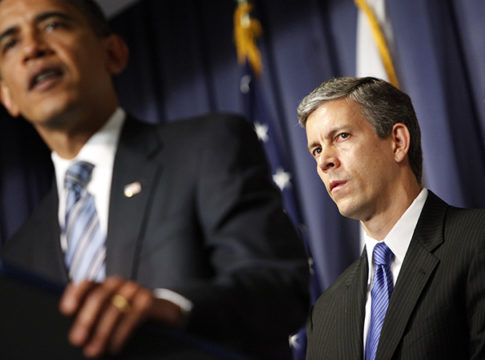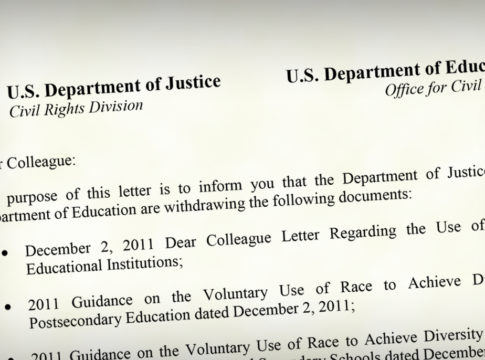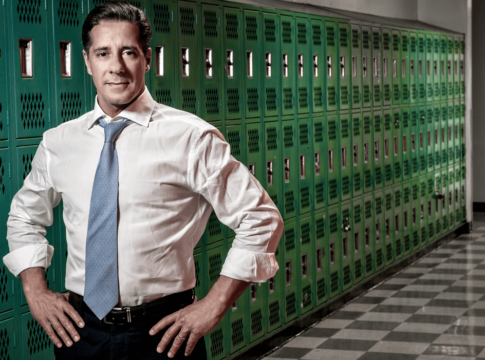We are now entering the fourth and final year of the first term of the Obama administration. Enough time has elapsed to provide an opportunity for at least an interim assessment, even though anything more definitive must await the voters’ judgment as to whether a second term is warranted.
At first glance, it looks as if President Obama and his secretary of education, Arne Duncan, have made surprisingly deft moves, both in terms of policy and politics. Even while Republicans are whacking the president “like a piñata,” as one pundit put it, they are treating his K–12 education record with kid gloves.
Senator Lamar Alexander has commented that he has “a lot of admiration” for Obama’s education secretary and “respect” for the president’s “positions on kindergarten through 12th-grade education.” Former House Speaker and presidential candidate Newt Gingrich admitted that this is “the one area where I very much agree” with him. New Jersey governor Chris Christie exclaims that the president has been a “great ally” on education reform. Former Massachusetts governor and presidential candidate Mitt Romney acknowledges that “some of his education policies” have been “positive.”
Is that for good reason? Is President Obama as strong on education reform as these comments suggest? On the surface, at least, the president has a compelling record. His Race to the Top (RttT) initiative catalyzed a chain reaction of legislative action at the state level, securing key reforms on issues ranging from charter schools to teacher evaluations to rigorous standards. His stimulus and “edujobs” bills seemed to maintain a critical level of investment in the public schools during a time of difficult budget cuts and financial strain. His administrative action to provide flexibility on No Child Left Behind’s most onerous provisions bypassed a paralyzed Congress and partially fulfilled his campaign promise to lift the law’s yoke off the backs of decent but maligned schools. And in Arne Duncan he’s got a popular, attractive education secretary to boot, one of the leading stars of his cabinet.
Plenty of these accomplishments are more than skin-deep. For example, both the Common Core State Standards effort and the move toward rigorous teacher evaluations could lead to dramatic increases in student achievement, if implemented faithfully by states and school districts. Neither of these reforms would have been adopted so quickly, in so many places, were it not for the president’s leadership.
Beyond these success stories, however, lie some very real weaknesses—soft spots in Obama’s education record—that raise doubts about the long-term impact of the administration’s efforts.
Wasteful Spending
There’s little reason to doubt that the American Recovery and Reinvestment Act—the 2009 stimulus bill—will long be remembered, along with health-care reform, as Obama’s signature accomplishment. For Democrats, the law saved the nation from a profound depression. For Republicans, as they made clear in the 2010 midterm elections, it constitutes a massive spending program that contributes to a national debt of historic proportions, with few results to show for it.
Accounting for nearly $100 billion (or about double the typical annual federal appropriation for education), the education portion of the stimulus package was one of its central components. In fact, setting aside the bill’s tax cuts, education spending represented the largest piece of the stimulus pie. These dollars were split into a few large categories: supersized spending for the Title I and special-education formula programs, and a “state stabilization fund” that essentially amounted to revenue sharing. (It also included funds for the $4 billion Race to the Top program, discussed separately below.)
Ostensibly, the intent of the education stimulus was to keep teachers from losing their jobs. The macroeconomic argument was that the last thing a damaged economy needed after the 2008 shock was to have hundreds of thousands of public school teachers getting pink slips, going on unemployment, and defaulting on their mortgages. And the nation’s schoolchildren would benefit as well. Protecting education jobs would keep good teachers from getting laid off and class sizes from skyrocketing. In February 2009, Secretary Duncan warned U.S. News & World Report about the consequences if the stimulus bill were not enacted. “My concern is that hundreds of thousands of good teachers, not just bad teachers, are going to go, and that would be devastating. It is to no one’s advantage if class size skyrockets or librarians get eliminated or school counselors disappear.”
This line of reasoning has two problems, as Duncan himself later admitted. First, good teachers were laid off because union protections required districts to implement reductions in force via “last in, first out.” If schools could have used the recession and budget crisis as an opportunity to cut their least-effective teachers, student achievement would actually have risen. As Stanford economist Eric Hanushek has shown, there is no quicker way to lift student improvement than to encourage the lowest-performing teachers to pursue other lines of work. Duncan himself does not disagree. In March 2011 he said, “Layoffs based only on seniority don’t help kids. We have to minimize the negative impact on students.’’
Second, there is little, if any, evidence that a modest increase in class size would have devastating consequences. Class size has fallen markedly over the past few decades. The year Obama was elected, the average number of pupils per professional in the public schools was 15, down from 19 in 1980 and 26 in 1960. In fact, even major layoffs would only return schools to the staffing ratios of the late 1990s, not exactly the Dark Ages, and a time of great progress in raising student achievement nationally. And again, even Duncan admitted as much when he later said that “class size has been a sacred cow and we need to take it on.”
Even when we evaluate the stimulus package on its own terms, protecting teachers’ jobs and keeping classes small, the costs seem wildly in excess of any benefits obtained. According to the Obama administration’s calculations, the stimulus package and edujobs bill kept about 400,000 teachers on the payroll who would have otherwise been terminated. That works out to approximately $150,000 per job, an exceptionally bad deal for taxpayers considering that the average new teacher (who would have been first in line for a pink slip) makes considerably less than half that in salary and benefits. Even if we accept the estimate of teachers’ jobs saved, we have to ask, where did the rest of the money go?
There is evidence that a significant portion of the funds did not go to stemming layoffs. Media reports indicate that some districts used the money for teachers’ raises and bonuses. The Government Accountability Office cited one North Carolina district for using edujobs dollars to pay for movie tickets, fast food, and a water park visit for students. This was in the midst of the worst economic downturn in six decades, when most Americans were either losing their jobs or barely treading water.
The design of the laws may, in fact, have aggravated the funding crisis at the local level. Forced to spend the funds relatively quickly, districts added staff, made new investments, and otherwise increased their costs, which will make the coming “funding cliff” that much more painful. At a time when tough-minded superintendents should have been preparing for leaner times by negotiating concessions from their bargaining units on salaries and benefits, federal policy cut them off at the knees.
Lackluster Results
Race to the Top is President Obama’s most vaunted win. The name itself connotes progress, forward movement, even competition. And there’s plenty of substance for the president to brag about: more than 45 states signing onto rigorous common standards; dozens of states getting serious about teacher evaluations; key jurisdictions removing caps on charter school expansion. This is what New Yorker contributor Steven Brill called “a sweeping overhaul” of the system. Look closer, put the Race to the Top’s results into context, and the scorecard changes considerably.
Secretary Duncan likes to say that RttT is part of a “quiet revolution” in education, with states creating “bold blueprints for reform [that] bear the signatures of many key players at the state and local level who drive change in our schools.” He’s right that the program led to a flurry of reform-friendly legislation. But did the 2009–10 period, when states were competing for RttT funds, see the most reforms ever enacted? No. That distinction belongs to 2011, after the 2010 midterm elections swept historic Republican majorities into office in state after state. While a similar number of states (5) made sizable progress on charter school caps in 2011 as in the previous two years, the number of states that moved forward on teacher evaluations, layoff policies, and vouchers increased significantly (see Figure 1).
Race to the Top wasn’t meant just to catalyze legislative changes. Winning states made bold promises about implementing their proposed reforms, and Obama and Duncan issued stern statements about their intention to pull dollars away from jurisdictions that fell short. How has that effort fared?
In short: not so well. Eleven states and the District of Columbia won first-round grants of up to $700 million from the $4 billion RttT pot in 2010, promising to deliver a range of ambitious programs and results. A little more than a year later, every one of those grantees has amended its plans at least once, with the Department of Education approving a grand total of forty-seven amendments to date. Maryland asked for another year to finish its teacher evaluation system, while North Carolina opted for a more modest teacher-retention bonus program. Time and again goals have been lowered and timelines extended. When in late 2011, in response to Hawaii’s stalling Duncan finally threatened to cut off the Aloha State’s funding, it marked a sharp and belated shift from the dozens of accommodating letters of approval that states wavering on their commitments have received from Washington.
Scaled-back ambitions are only half the problem: many states seem to have barely started putting their plans in motion. As of May 2011, a year after the first RttT awards, just over $80 million of the $4 billion in funding had actually been spent. While it’s at least reassuring that states haven’t been burning through the money, the urgency of the “Race” petered out once the awards were made. With the latest round of RttT grants awarded with little fanfare, the Obama administration’s signature effort is losing steam.
Federal Micromanagement
Complaining about an overbearing federal role in education is a mainstay of Republican campaigns, particularly during primary season, when the battle cry of “local control” most resonates with likely voters. The current nomination contest is no exception, with all of the GOP candidates calling for a smaller federal footprint, if not the outright closure of the Department of Education.
This message is more problematic during general elections, when voters (especially all-important independents) can easily equate a conservative’s plea to “pull back” as an indication of disinterest.
But in skillful hands, painting Uncle Sam as school-yard bully could work.
“We’re going to let states, schools and teachers come up with innovative ways to give our children the skills they need to compete for the jobs of the future,” promised Obama when announcing his NCLB waiver plan. “Because what works in Rhode Island may not be the same thing that works in Tennessee—but every student should have the same opportunity to learn and grow, no matter what state they live in.” Duncan echoed, “instead of being tight on the goals and loose on the means of achieving them, [NCLB] is loose on the goals but tight on the means. We need to flip that and states are already leading the way.”
But for all the talk of state discretion, the Washington screws are actually being tightened. Take the Race to the Top, which one of us once characterized as “a carrot that feels like a stick.” Rather than invite states to present their own compelling reform plans, Obama and Duncan asked governors and state superintendents to develop plans that complied with federal guidelines set forth in excruciating detail. Or take their approach to NCLB waivers, in which they set constitutionally suspect conditions on the flexibility craved by the states (see “Obama’s NCLB Waivers,” forum, page 56). As Senator Alexander remarked, the Obama administration had states “over a barrel.”
And when it comes to federal control, nothing is more troubling than the declaration that a disproportionate percentage of white students in Advanced Placement (AP) classes constitutes evidence of racial discrimination. That’s the administration’s stance, thanks to the Department of Education’s civil rights branch, led by poverty warrior Russlynn Ali. At the very time Duncan was espousing the virtues of state and local flexibility, he and Ali were doubling down on 1960s-style top-down regulations. One stated objective was to address the “disparate impact” of policies that might lead to racial minorities taking fewer challenging classes than their peers, totally ignoring the obvious fact that African American and Hispanic students are, on average, much less prepared for AP courses by the time they reach 11th and 12th grade. Never mind that closing this preparation gap requires a long-term effort starting in elementary school, if not before. The federal government put districts on notice that if they had a disproportionate number of white students in AP classes, they could be immediately subject to civil rights enforcement. This is tight-loose?
Obama and Duncan have been good on education reform, certainly better than any of their Democratic predecessors. But to ignore the shortcomings of the president’s K–12 education-reform record entirely would be a mistake, we think. And it would also be bad for the country. The administration deserves to be pressed on the cost-effectiveness of its education system bailouts, on the results of its Race to the Top initiative, and on the wisdom of its approach to federalism and separation of powers. Education may not play a major role in the 2012 election, but that doesn’t mean that Obama’s education policies should be given a pass.
Michael J. Petrilli is research fellow at Stanford University’s Hoover Institution and executive vice president of the Thomas B. Fordham Institute, where Tyson Eberhardt is a research fellow.
This article appeared in the Spring 2012 issue of Education Next. Suggested citation format:
Petrilli, M.J., Eberhardt, T. (2012). Obama’s Education Record: Does the reality match the rhetoric? Education Next, 12(2), 39-43.








